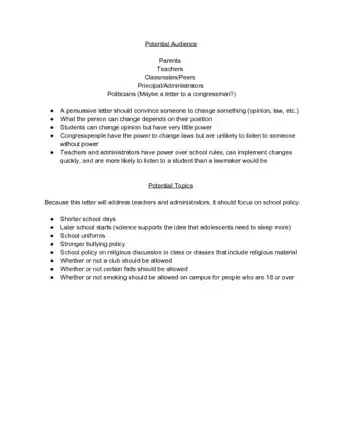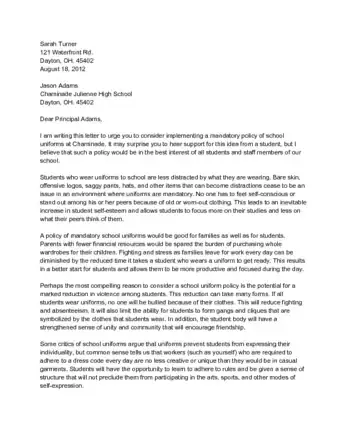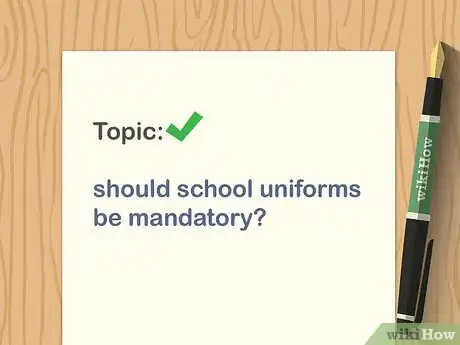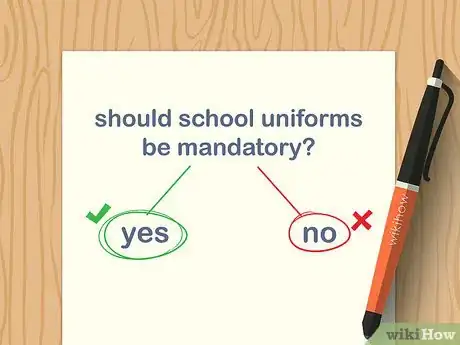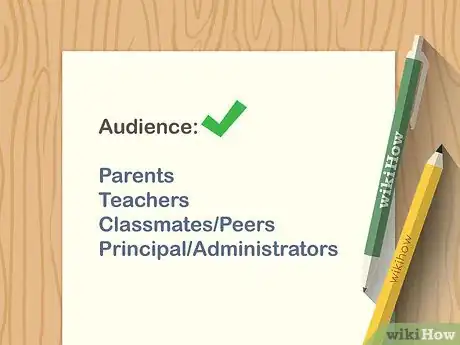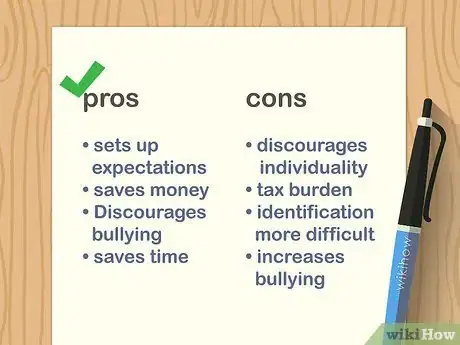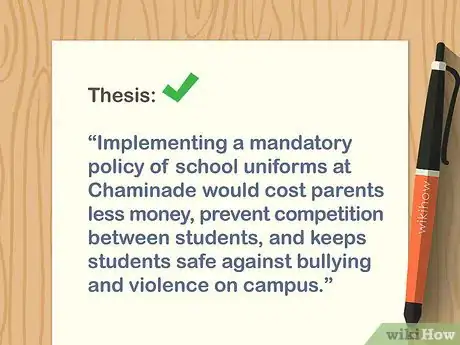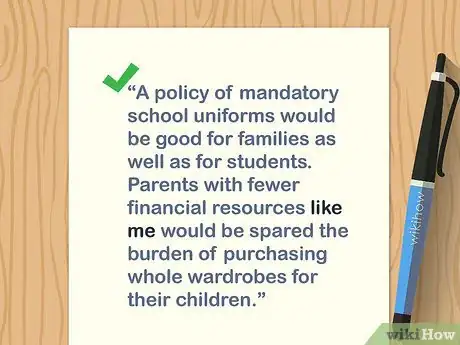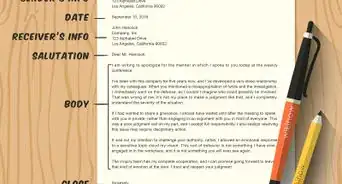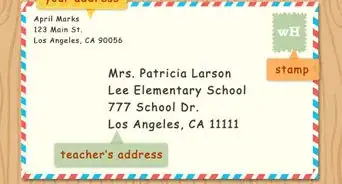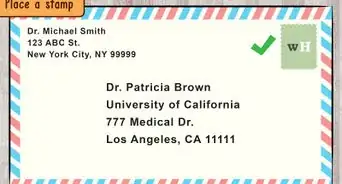This article was co-authored by wikiHow Staff. Our trained team of editors and researchers validate articles for accuracy and comprehensiveness. wikiHow's Content Management Team carefully monitors the work from our editorial staff to ensure that each article is backed by trusted research and meets our high quality standards.
This article has been viewed 264,215 times.
Learn more...
It can be tough to write a persuasive letter, whether it’s for a school assignment or for a personal interest. In a persuasive letter, you’ll need to try to convince a person or group of people to agree with your side of an argument. A pros and cons chart is a great way to break down points that you can use to persuade your readers. The chart will also allow you to incorporate the “cons” into your letter so you can disprove and dismiss them.
Steps
Persuasive Letter Help
Selecting a Letter Topic
-
1Pick a topic that you would like to write your letter about. Make sure that it has several sides and that you are familiar with the topic. Do some research to make sure that you are aware of all of the different sides on this topic, so that you can represent them in the pros and cons charts. If you're given a range of topics for a school assignment, write about something that you're passionate about.
- For example, if you’re passionate about the wellbeing of marine animals, you could choose to write about the ethics of using them for product testing and experimentation.
- It's difficult to write a convincing letter about something you don't care about.
-
2Word your topic so that it’s answerable by a “yes” or a “no.” This will ensure that your topic is defensible and well worded. Your topic should be clear-cut and should have strong arguments to support it. A topic like “Should cigarettes be marketed to teens?” is better worded than a topic like “Should cigarettes be marketed to teens, adults, and the elderly?” because it is more specific.[1]
- For example, the topic “murder should be legal” is not defensible, since there are no convincing arguments that support an answer of “yes.”
- So, a topic like: “Should the state pass legislation forbidding drivers to text while driving?” is much better.
Advertisement -
3Research both sides of the topic to ensure you fully understand it. Researching is an important component of preparing to write a persuasive letter. Start your research by searching for opinion pieces about your topic online. Also look for articles about your topic by respected online and print news media.
- For example, there may be valid reasons that someone would object to the state passing legislation to prohibit in-car texting. But, you’ll never be able to account for and counter these reasons if you don’t put in the research to find them out in the first place.
- Maybe many people feel that that legislation wouldn’t go far enough, and that the state should ban cell phones in cars altogether, no matter what they’re being used for!
-
4Determine the age and occupation of the letter’s audience. The tone and content of your written letter will differ based on the intended audience. So, are you writing to students and kids who are your own age? Your school principal? Adults? Political representatives and decision makers?
- When dealing with an older audience, you can use a more sophisticated vocabulary. The inverse applies when dealing with a young audience.[2]
- For example, for an older audience, write something like, “A lasting political commitment to phone-free driving will ensure the survival of many who otherwise could lose their lives to a distracted driver on the phone.”
- On the other hand, for a younger audience, write, “Not allowing people to use phones in the car will reduce accidents. This will help keep more people alive.”
Compiling the Pros and Cons Chart
-
1Fill out pro and con columns on a sheet of paper. The first of these charts is the “pros" column, and the second is the "cons" column. In the "pros" chart, fill in several reasons supporting your argument. Try to come up with 5-7. Use bullet points to give evidence supporting your reasons. Do the same on the "cons" side, except list and provide reasoning against your argument.[3]
- For example, say you’re writing about banning cell phone use in cars. Under the pros column put “could help save lives.” You can also write, “helps drivers focus on driving,” and “reduces risk of accidents.”
- Under the cons column, you could write something like, “over-legislates private behavior” and “people may need to make emergency calls with their cell phone.”
-
2Keep emotional distance from the issue you’re evaluating. An advantage of a pros and cons list is that it lets you look at issues from a non-emotional, objective stance. It’s easy to get caught up emotionally in issues like testing products on animals or unsafe driving practices. But, when making the list, leave emotions out and focus on including only rational, defensible claims.[4]
- For example, when making a list of cons for any issues, writing something like, “I personally dislike it” or “It makes me unhappy” is a very weak reason.
-
3Consider how the “cons” can be overcome. Since you'll try to persuade your audience to embrace 1 side of your chart over the other in your letter, you'll need to address solutions to the "cons." As you’re jotting down the “cons,” think of flaws in the arguments that would support them, or consider ways in which the “cons” are misleading or irrelevant to the issue.
- Or, if you don't believe that the "cons" need to be solved, you could find information that proves those arguments wrong.
- For example, if you're writing about the issue of texting while driving, you’ll need to address the con that it “over-legislates private behavior.” Write something like, “This argument is irrelevant. Texting while driving affects more than one individual since many people can be killed by a careless driver who is also texting.”
- You can then add this sentence directly to your letter once you’re writing it.
Writing Your Letter
-
1Outline the paragraph layout of your letter. At this point, you can use bullet points or a numbering system. You just need to figure out what order you want your paragraphs in to maximize the letter’s persuasiveness. For example, you could write an introductory paragraph, followed by a paragraph outlining the pros, a paragraph outlining the cons, and a conclusion paragraph.
- If you have more pros than cons, devote 2 paragraphs to the pros and whatever reasoning you have for supporting them.
- For example, you could write 1 paragraph describing the issue of cell phone use in cars and follow it up with an impassioned paragraph describing all of the pros and your reasons for supporting them. Next, write a paragraph describing the cons and your arguments for refuting them. Finally, conclude the letter with a call for action.
-
2Convey the letter’s topic and your stance on it in a thesis sentence. You can place this sentence at the end of your opening paragraph if you like. To write a persuasive thesis, simply state your argument. This will let your readers know exactly what you’re trying to persuade them of. It’s important to do this in a persuasive letter, so you’re not just rattling off a bunch of pros and cons.[5]
- For example, you could write something like: “Marine animals should not be captured for scientific studies since it’s unethical to perform experiments on living creatures.”
- This type of straightforward beginning will let your readers know exactly what you plan to persuade them of.
-
3Include supportive statistics to add a persuasive research component. You could also include supporting quotations. Do some research before you come up with reasons supporting your arguments, and incorporate this research into the finished product. Using data and quotes will let your readers know that you’re not pulling ideas out of thin air, but that you’re trying to convince them of sound and proven ideas.[6]
- For example, if you’re writing about the need for legislation against texting and driving, write something like, “A poll by the Pew Research Center suggests that over 75% of current drivers text while driving and plan to continue. This statistic is staggering, and indicates how badly we as a country are in need of a solution.”
-
4Add an anecdote to give your letter a personal touch. A great way to persuade someone is by telling them about a personal experience. Your anecdote could be lightly humorous or poignant and touching but should largely address the issue your letter focuses on. Adding an emotional appeal is a great way to boost the persuasiveness of a letter.[7]
- For example, if you’re writing about the issue of marine animal testing, write something like, “Dozens of animals are confused and in pain every day all because some unethical companies feel the need to unnecessarily test out products. I know because I once visited an animal testing center and was shocked by the unethical animal treatment that I observed.”
-
5Proofread your letter for errors once you've finished writing. Read through the letter and correct any grammatical mistakes. Also, improve any awkward wording, and tighten up your arguments where you spot a flaw. If you have the time, try reading your letter out loud to yourself or someone else. This can help you catch errors or grammatical oddities that you wouldn’t have noticed otherwise.
- If you’ve written the letter for a school assignment, you’re ready to turn it in.
- Or, if you’re using the letter to influence policy, look up the address of the person you're sending it to, then drop the letter in the mail!
Community Q&A
-
QuestionHow do I end a letter?
 Community Answer6 ways to end a letter. 1. With anticipation. 2. Regards. 3. Thanking you, _____ (which can be followed by the following) 4. Respectfully yours. 5. Yours faithfully. 6. Yours sincerely.
Community Answer6 ways to end a letter. 1. With anticipation. 2. Regards. 3. Thanking you, _____ (which can be followed by the following) 4. Respectfully yours. 5. Yours faithfully. 6. Yours sincerely.
References
- ↑ https://leandecisions.com/2012/09/10-tips-for-better-pro-con-lists.html
- ↑ https://www.grammarcheck.net/ten-important-triggers-for-persuasive-writing/
- ↑ https://www.mindtools.com/pages/article/newTED_05.htm
- ↑ https://hbr.org/2017/01/the-pros-and-cons-of-pros-and-cons-lists
- ↑ https://www.kibin.com/essay-writing-blog/write-pros-and-cons-essay/
- ↑ https://www.grammarcheck.net/ten-important-triggers-for-persuasive-writing/
- ↑ https://www.grammarcheck.net/ten-important-triggers-for-persuasive-writing/
